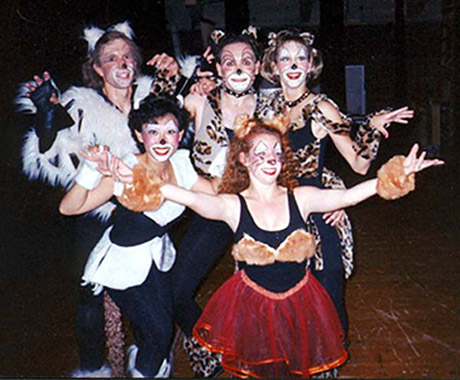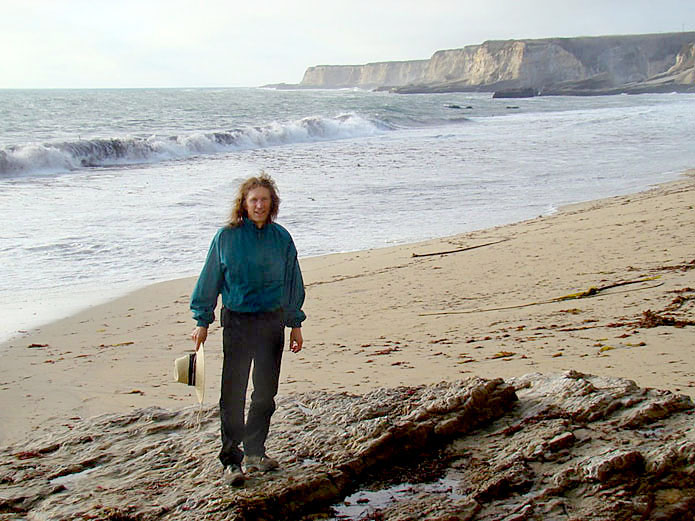|
|
"Those who hear not the music, think the dancers mad." - Author Unknown "Arrowcatcher" is the nom de plume for James Duncan, born June 1948. In early school days I skipped from kindergarten to second grade, which made me always one year younger than other students at my level. I was 6 and could read well at a 4th grade level. I'm an asynchronous development case. I tinkered with things and became a General Class Radio Amateur operator when I was 12, preferring to use CW (Morse Code) since one can communicate internationally without knowing other languages. When I was 13 my parents bought me a 40' Rohn tower and a Hornet tri-band beam for my birthday. I enjoyed climbing on the tower to put up secondary antennas, etc. I played classical piano and taught myself about the repertoire from listening to the radio. I socialized more with adults than my peers. Looking back, I deeply regret failing to acknowledge the help adults gave me. Not an average childhood and adolescence, for better or worse. In high school I graduated near the top of my 1965 class and had studied 4 years each of French and German as well as math through calculus. I got a UC Berkeley BA degree in 1970. After UC I entered Denver University's Graduate School of Mass Communications but ended my student career early. At UC Berkeley I was chief engineer of student station KALX-FM and a classical music on-air programmer. At Denver University I had a Music Department Fellowship to record and document student recitals and performances. While there I was chief engineer of KCFR, Denver and installed their initial 10 watt transmitter at the top of the campus library building. On dropping out of graduate school I became a California commercial FM broadcast engineer - my continuing career for more than a quarter century. I am a Society of Broadcast Engineers Certified Professional Broadcast Engineer, leaving the field in 1996 to become a computer systems administrator for small business and as well a webmaster. I also do professional photography, generally of high end West Coast real estate for a Central California real estate company. In 1969 under the supervision of Professor Al Eisberg at UC Berkeley's Electrical Engineering department, I became the only UC undergraduate on whose behalf they had ever made a patent application. It was a novel radio transmitter design that used an absolute minimum part count. This key feature made it attractive and elegant. The underlying concept had been anticipated in 1953, but it was an interesting experience. It's likely, but not certain, that I still hold this undergraduate distinction in the UC system.
Every week as I drove to radio station studios I would stop at a B. Dalton bookstore as well as several used book stores to buy books on Western and Eastern philosophy. Becoming an avid reader, I read Tolstoy's War and Peace in one long sitting on a day off. To me the Napoleonic War assault on Moscow was incidental to the introspections of lead character Pierre Bezukhov in that great classic. I was looking literally everywhere for clues and was a confirmed autodidact. To mull what I was reading I would take long walks at Ed Levin Park in the hills behind my San Jose, California rented home at the time. Friends and associates were sure I was on drugs in this "retreat" (never the case). I started a hand written journal which grew to roughly 250,000 words in a large pile of legal pads. When time allowed, I took my sleeping bag and lots of water to Pinnacles National Monument, about an hour-and-a-half south, and camp in my station wagon. I did this in the middle of summer as hot temperatures - often over 100° F/38° C - emptied the park of visitors, and I could hike all alone to the highest peaks in this picturesque spot and crystallize a flood of new ideas. I carried gallon jugs of water and sometimes poured them on my head for cooling. It was an improvised "vision quest" (retrospective label). To make keep the story short, I realized that I could possibly synthesize an "accurate" spiritual system of my own by digesting a maximally diverse range of the world's thinking on the subject. In particular it was my thought to sift out commonalities in philosophical and spiritual thought from the widest possible range of readings and thought. Gradually as well, all life and work activities became integrated into this process. Every action came to be a sort of spiritual exercise. I can't claim I have done this overall pattern perfectly - there has been a lot of trial-and-error. There is no "guru" nor other direct advisor. My technical communications career provided a feast of conceptual analogies for Open Mystic. I intentionally created and propagated electromagnetic radiation as a radio engineer for a paycheck, and the knowledge dividends far exceeded the value of money payments received. The Open Mystic website is a compressed version of the synthesis that I created and live by. At this time, the monograph is neither fully coherent nor complete. In the near future I hope to expand the ideas here properly and hopefully with reasonable rigor. Open Mystic may never impress academic philosophers, who often strive to be reductionist and verbal. Open Mystic is more in the mold of a holistic mysticism I suppose, which is why I suggest interested visitors view relevant references on the Links page. Astrology chart made in 1972 (by Gary Lyte) for those who might be interested. My favorite computer operating systems (OS) are Suse Linux and Windows 7. In 1985 I chose the "IBM PC" because it is an open architecture. I was once very good with System 5 UNIX. UNIX/Linux is the superlative OS structure. Windows itself is not open source, but it engendered a worldwide application software open development scenario. I try to make choices that mirror underlying philosophies. This happens with everyone else in effect, but I do it consciously to the greatest extent possible. It turns out to be fun. Photo: January 2010 at age 61. On my 56th birthday I decided never to cut my hair again.
More photos below - I dreamed up the Open Mystic "broad temporal aperture" rubric
long ago and try to "walk-the-talk" to the best of my ability. Open Mystic visitors may
know or be able to cite "Renaissance" persons who are far more accomplished than
I am. However, the Open Mystic proposal is that any individual should
actualize and optimize whatever diverse range of abilities they can to the best
of their ability. In so doing, it is proposed that such persons may be better
positioned to apprehend esoteric knowledge if they wish to do so. The
photos and links below are representative of both technical and artistic skills
in the broadest way possible for me.
|
foreword - please read first |
site map |
go to page1 |
|













 These
are my telescopes. No "philosophical" implications. This is
just fun. Left is a 254 mm reflector, and on the right is a 152 mm
refractor. The night sky here varies between limiting magnitude 4 to 5,
so I can use my driveway. These have dual-axis motor control and
can compensate Earth's rotation, but there's no "goto". My
favorite sky map is
These
are my telescopes. No "philosophical" implications. This is
just fun. Left is a 254 mm reflector, and on the right is a 152 mm
refractor. The night sky here varies between limiting magnitude 4 to 5,
so I can use my driveway. These have dual-axis motor control and
can compensate Earth's rotation, but there's no "goto". My
favorite sky map is 